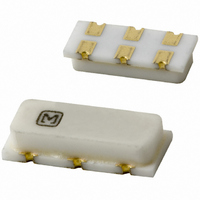EFO-S6004E5 Panasonic - ECG, EFO-S6004E5 Datasheet

EFO-S6004E5
Manufacturer Part Number
EFO-S6004E5
Description
CERM RESONATOR W/CP 6.00 MHZ SMD
Manufacturer
Panasonic - ECG
Series
EFO-Sr
Type
Ceramicr
Datasheets
1.EFO-SS4004E5.pdf
(5 pages)
2.EFO-SS4004E5.pdf
(2 pages)
3.EFO-SS4004E5.pdf
(1 pages)
4.EFO-SS4004E5.pdf
(1 pages)
Specifications of EFO-S6004E5
Frequency
6MHz
Features
Built in Capacitor
Frequency Stability
±0.2%
Frequency Tolerance
±0.5%
Capacitance
33pF
Operating Temperature
-20°C ~ 80°C
Mounting Type
Surface Mount
Package / Case
3-SMD, Non-Standard
Size / Dimension
0.307" L x 0.126" W (7.80mm x 3.20mm)
Height
0.063" (1.60mm)
Lead Free Status / RoHS Status
Lead free / RoHS Compliant
Other names
EFOS6004E5
PX6004E5
PX600STR
PX6004E5
PX600STR
Ceramic Resonators, Chip Type.
(3 Array Type)
Ceramic Resonators, Chip Type.
(2 Array Type)
■
Design and specifi cations are each subject to change without notice. Ask factory for the current technical specifi cations before purchase and/or use.
Should a safety concern arise regarding this product, please be sure to contact us immediately.
1 Fail-Safe Design for Equipment
2 Operating Temperature Ranges
3 Changes/Drifts in Oscillating Frequency
4 Abnormal Oscillation
5 Stray Capacitance
6 Matching Capacitors
Design Engineering Notes
When using The Ceramic Resonators, it is rec om -
mended that you build a protective failsafe circuit
into your de sign to prevent equipment damage in the
event that the resonator malfunctions or fails.
The Ceramic Resonators should not be operated
beyond the “Operating Temperature Range” speci-
fi ed in the catalog.
Oscillating frequency may drift depending upon the
controlling IC and/or external capacitors C
C
Note: ✽Refer to “Standard Test Circuit Diagram” in the catalog or
The Ceramic Resonators are always accompanied
by spurious resonances. Spurious oscillations or
stoppage of oscillation may occur depending on the
circuit design (IC used, frequency characteristics
of the IC, supply voltage etc.) and/or environmental
conditions. These factors should be taken into
consideration when designing the circuit.
Stray capacitances and insulation resistances on
printed circuit boards may cause abnormal oscillation
or stoppage of oscillation. These factors should be
taken into consideration when designing the circuit.
When using The Ceramic Resonators of Type PM
and LM/P/D/PS/DM, two selected capacitors
should be added for constructing “Colpitts Oscillation
Circuit”.
Note: ✽✽ The capacitance values are specifi ed in the catalog.
2
✽
used in the circuit design.
the individual specifi cation.
Handling Precautions
1
✽
and
✽✽
– EC175 –
Type S/B/SS/SM/BM/JM
Type P/D/PS/PM/DM/LM
■
■ Application Notes
1 “Flow Soldering” should not be used to solder ceramic
2 “ Ultrasonic Cleaning” and “ Ultrasonic Welding”
3 Avoid washing in water because it could deteriorate
4 Avoid resin coating or potting for humidity protection
1 Overvoltage Spikes & Electrostatic Discharges
2 Abnormal Mechanical Stresses
3 Surface Mounting Consideration
Prohibited Applications
resonators.
should not be used on ceramic resonators.
the resonator's performance characteristics.
because it could deteriorate the resonator's
performance characteristics.
Voltage spikes and electrostatic discharges may cause
damage/malfunction or failures of the resonators.
Abnormal / excess mechanical stresses such
as vibration or shock should be avoided when
handling/storing res o na tors to prevent damage and
cracking.
In automated mounting of The Ceramic Resonators
on printed circuit boards, any bending, expanding
and pulling forces or shocks to The Ceramic Reso-
nators should be kept to a minimum to prevent
electricalfailures and/or mechanical damage to the
devices.
Ceramic Resonators, Chip Type
01 Feb. 2009
Related parts for EFO-S6004E5
EFO-S6004E5 Summary of contents
Page 1
... Note: ✽✽ The capacitance values are specifi the catalog. Design and specifi cations are each subject to change without notice. Ask factory for the current technical specifi cations before purchase and/or use. Should a safety concern arise regarding this product, please be sure to contact us immediately. ...
Page 2
... Peak Soldering Temperature: 250 °C max. Design and specifi cations are each subject to change without notice. Ask factory for the current technical specifi cations before purchase and/or use. Should a safety concern arise regarding this product, please be sure to contact us immediately. ...











